Hoshin Kanri is a management method that arose in Japan after World War 2. Because it was extremely effective, it soon caught the attention of companies in other countries. These days, you can find people using the principles of Hoshin Kanri worldwide.
方 針 管 理
Hoshin: Compass
Kanri: Management
Hoshin Kanri: You need direction in order to have effective management.
This method helps you to:
- Build strategic plans.
- Set and achieve goals.
- Create consistent tactics.
- Improve communication between management and staff.
- Let your staff focus on performance.
Principles of Hoshin Kanri
Hoshin Kanri:
- It is top-down; upper management mandates goals.
- Requires communication along the chain of command.
It involves:
- Planning: focusing on the things that really affect the company’s success.
- Preparing workable strategies: developing a firm focus and workable plans with top management.
- Preparing and evaluating KPIs: selecting essential business metrics to achieve your goals.
- Keeping on track: regular follow-ups at all levels, from top management to operation staff.
Hoshin Kanri Steps
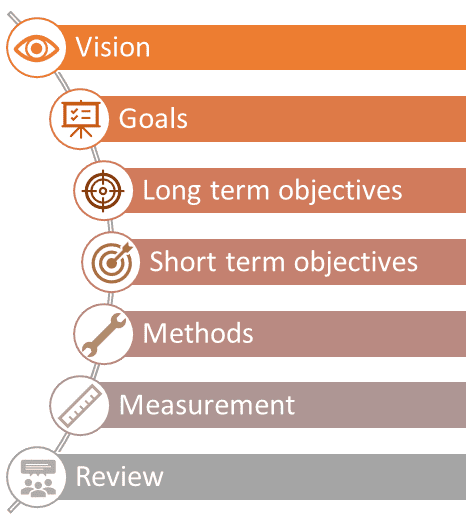
The basic steps in a Hoshin Kanri process are:
- Develop a strategic vision.
- Use the vision to decide company-wide goals spanning 1-5 years.
- From these goals, extract yearly objectives.
- Break down yearly objectives into monthly and weekly objectives.
- Develop and agree on the measures used to meet objectives.
- Measure progress toward these objectives monthly.
- Conduct an in-depth progress review annually.
When to Use This Method
Use Hoshin Kanri if:
- You’ve been struggling to meet your annual goals.
- Your staff performance isn’t improving.
- You have a clearly defined top-down management structure.
- You’re willing to take the time to ensure clear communication channels.
- Your decision-makers are prepared to listen to staff feedback.
The 4 Phases of Hoshin Kanri
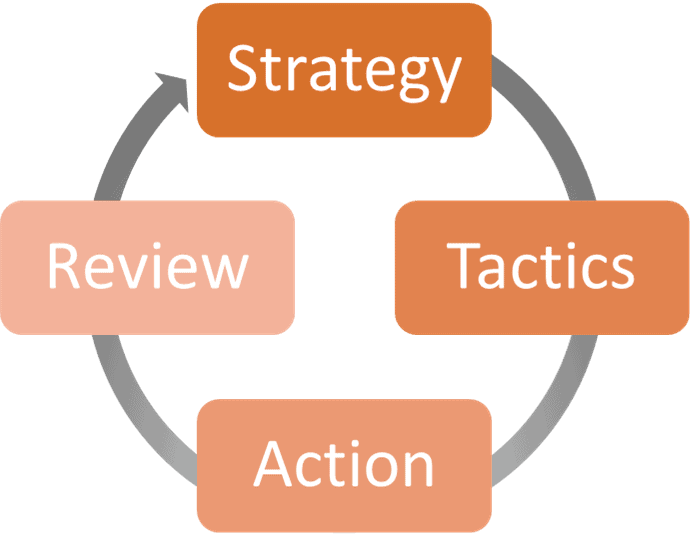
Phase 1: Strategy
Who: Top management
Someone must decide where the company is going and how to get there.
Think of this phase as planning a family holiday. You probably won’t give everyone in the family a vote in deciding where to vacation, and you certainly won’t let the kids decide the driving schedule. They don’t have the experience or knowledge to plan these strategic points.
Likewise, the strategic choices need to be made by upper management. They should determine the company vision and then develop long-term goals based on it.
Vision can come from company-wide existential issues, key imperatives, or strong beliefs about the future. Porter’s 5 Forces may play a key role.
Next, break down those goals into annual, monthly, and weekly objectives. Then, figure out how to measure whether the company reaches those goals. Consider using OKRs, KPIs, & KPOs.
Phase 2: Tactics
Who: Middle management
The next step is to figure out how to make these objectives happen. In this stage, middle management takes the objectives created by top management and develops tactics for each objective.
In this phase, the Hoshin Planning Matrix is the key tool.
How to Make the X Matrix
How to Cascade Hoshin Kanri through the Organization
Phase 3: Action
This phase is about communicating the plan down the chain of command and then putting it into action.
Reporting and project managers hold meetings with supervisors or team leaders. These meetings outline the tactics developed and discuss how to implement them in each team. They help build an understanding of the measures and how each staff member is key to making them happen.
Phase 4: Review
This phase is all about analysis. Middle management looks at how their tactics are working. Top management uses key metrics to measure progress toward their objectives.
In a sense, this is the ‘reverse flow’ phase. Until now, communication has flowed downwards from the top management to the staff. However, communication needs to move back up the chain of command. Staff talk to their team leaders. Team leaders talk to managers. Managers talk to middle management. Middle managers talk to top management.
Top managers look at all the data that has flowed back. They analyze it thoroughly to determine the following:
- How are we progressing? Are we meeting KPIs?
- What are the current blocking factors? What can we do about them?
Some options to deal with a lack of sufficient progress are:
- Modify objectives to make them more realistic.
- Adjust the tactics being used to achieve those objectives.
- Fix issues that are blocking staff from successfully completing their tasks.
How to Make a Hoshin Kanri Matrix
Find or make a template.
Firstly, you’ll need a template for your matrix. Keep a blank one available, as you’ll need to repeat the process at regular intervals. It needs to look fairly close to this:
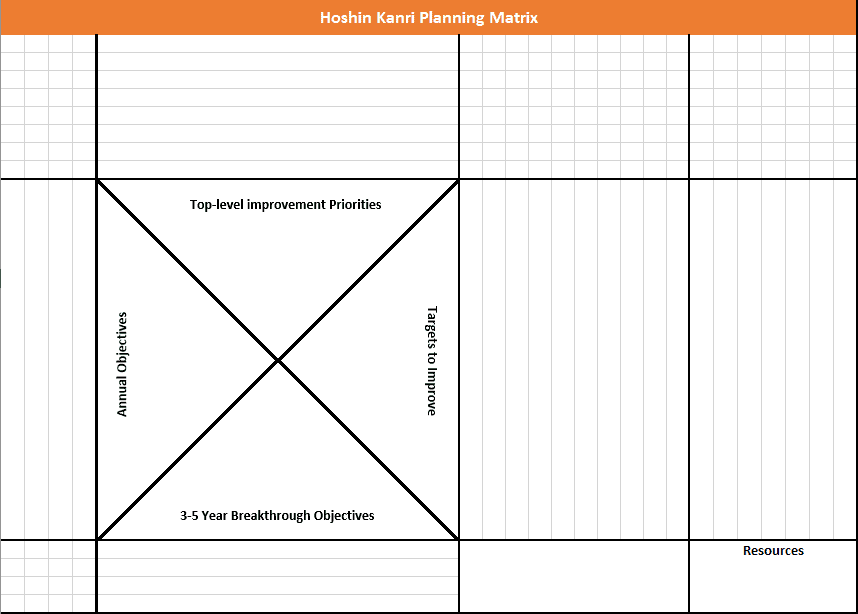
Using Excel or another spreadsheet program to create the template is easiest.
Fill in your matrix.
Your long-term objectives go in the bottom (south) quadrant.
Then, work your way clockwise around the quadrant. Add annual objectives for the next year only in the left (west) quadrant.
Next, the most important tasks that your team needs to complete in order to achieve those annual objectives. Add these to the top (north) quadrant.
And lastly, the metrics that will help you know whether you’re hitting your targets. These go in the right (east) quadrant.
On the far right (above Resources), list the people who will own or be responsible for completing the activities. These are typically managers rather than general staff.
Mark your dependencies
Everyone does this step a little differently. Some teams use only a single marker, and others use several. But the purpose is to show, at a glance, which objectives, tasks, and metrics are related and (if desired) how.
The best way to get a feel for what might work is to look at what others have done. You can find a lot of sample Hoshin Kanri matrices by searching Google Images for ‘hoshin kanri matrix.’ Remember that your primary priority needs to be making the matrix easy to read at a glance.
Share the matrix
Help people understand their new tasks’ purpose by sharing the matrix throughout your team.
Example Planning Matrix
A copper pipe manufacturer wants to increase its long-term profit margins.
Phase 1: Strategy
Its top management meet and decide on a three pronged approach:
- Decrease the number of faulty units per thousand.
- Improve staff well-being.
- Impose stricter quality assurance measures.
Next, the team develops annual objectives from these:
- 5% decrease in number of faulty units per thousand.
- 10% decrease in employee sick leave.
- 20% decrease in overtime worked.
- Automate 10% of QA tasks.
Then, the team decides on metrics to use:
- Defects per unit.
- Average days of sick leave per employee.
- Average hours overtime per employee.
- Number of automated QA tasks / total number of QA tasks.
Phase 2: Tactics
Middle management develops tactics for the annual objectives:
- Quarterly analysis and review to decrease variation in processes.
- Give employees an extra week’s annual leave this year.
- Employ and train one casual worker for every five employees. Use these rather than asking for overtime.
- Bring in an automation consultant.
Fill in the matrix.
To fill in the matrix:
First, you enter the long-term objectives in the south quadrant.
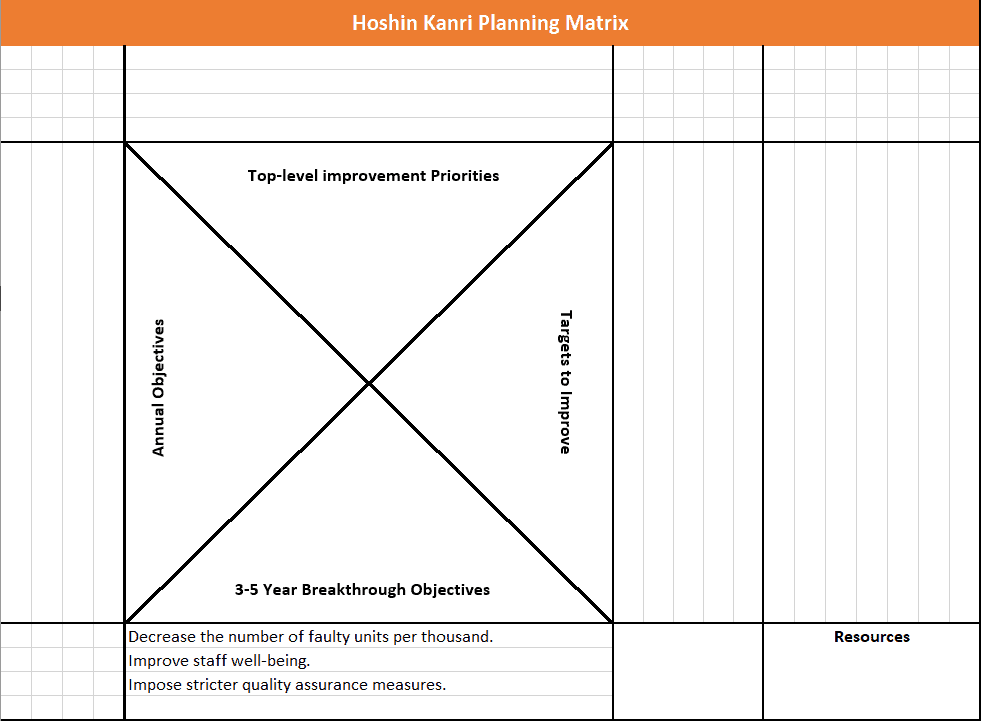
Next, add this year’s annual objectives to the west quadrant.
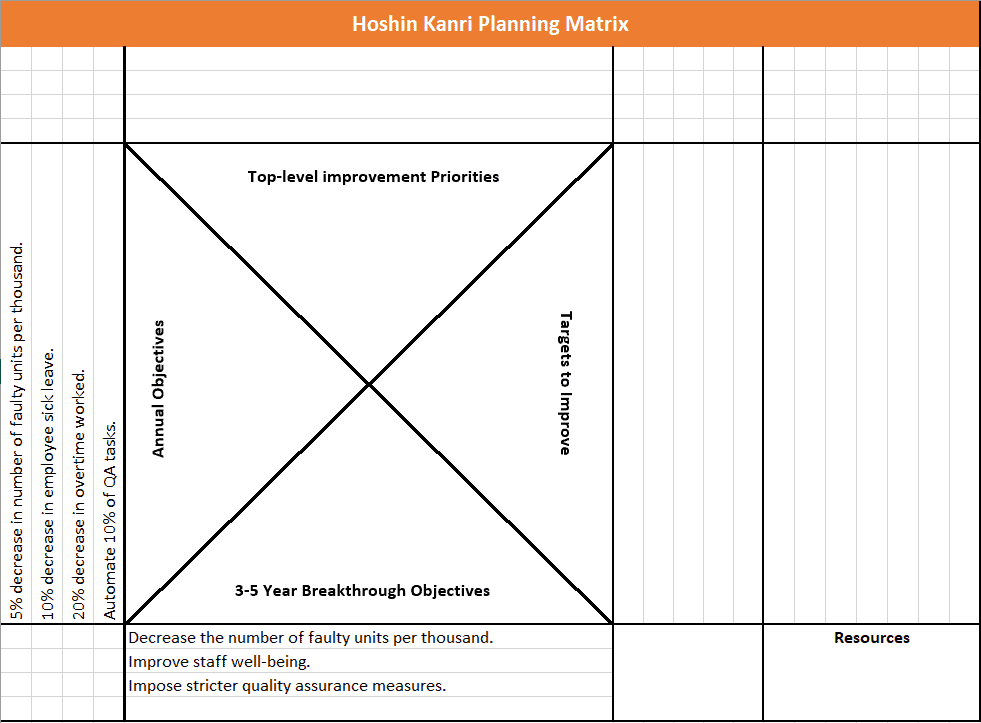
Then, enter the tactics in the north quadrant.
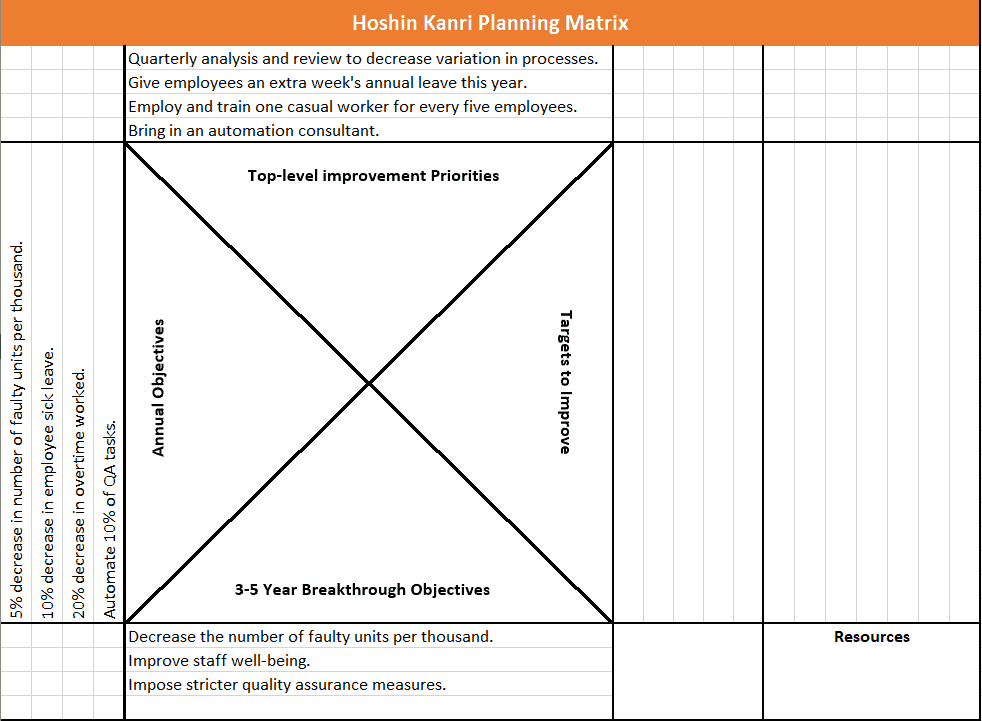
Add key metrics to the east quadrant.
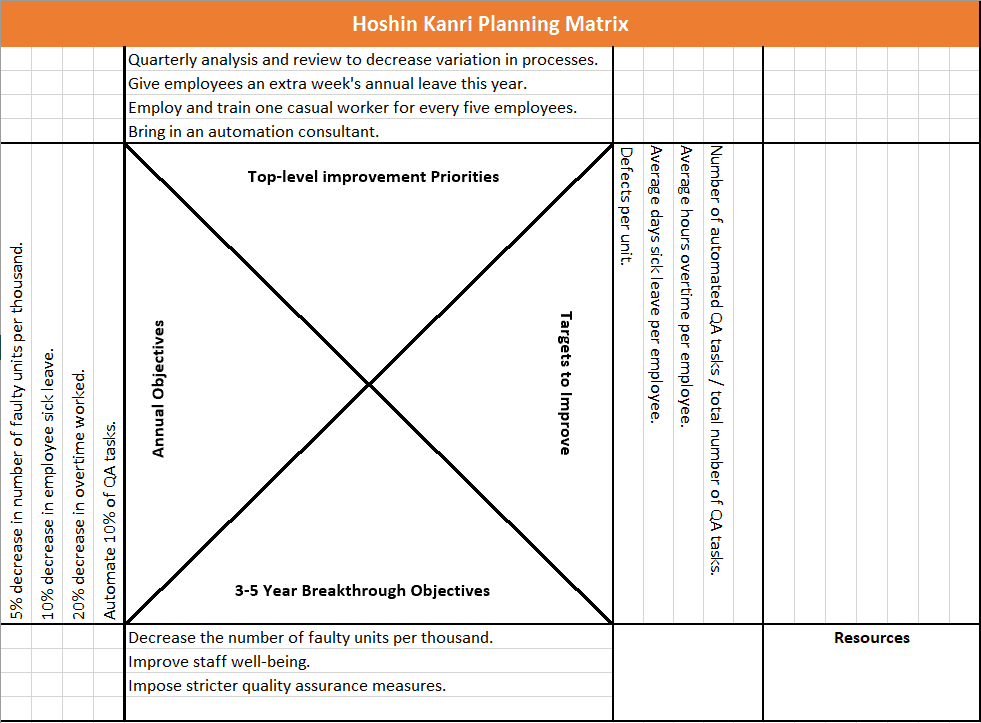
Enter key personnel in the far sector of the east quadrant.
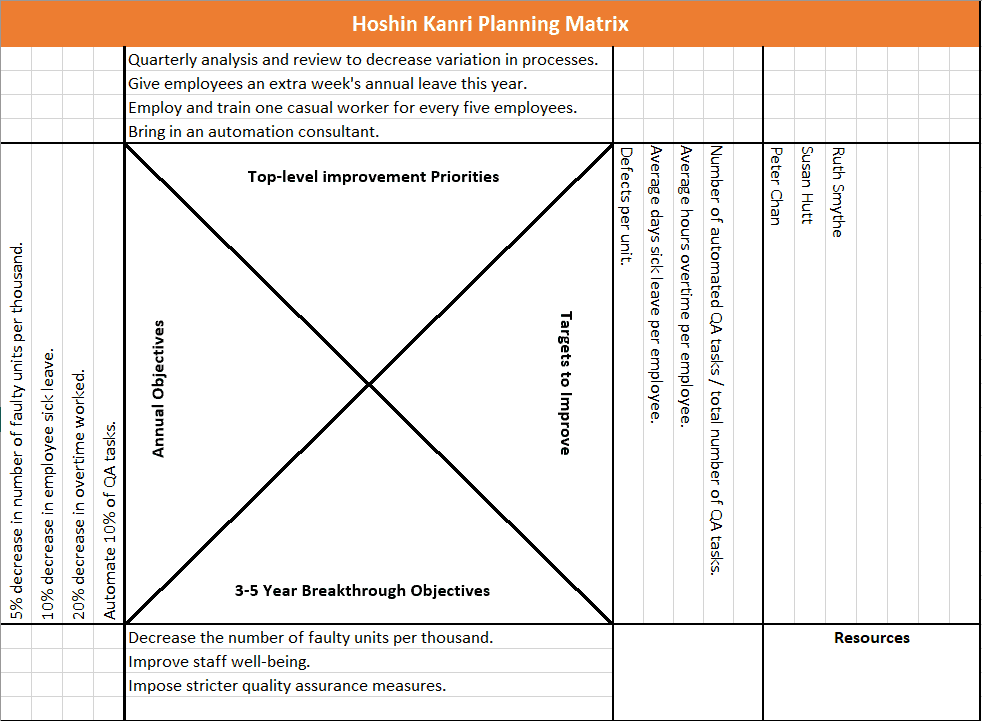
Finally, map each quadrant to its neighbors.
The filled-in matrix looks like this:
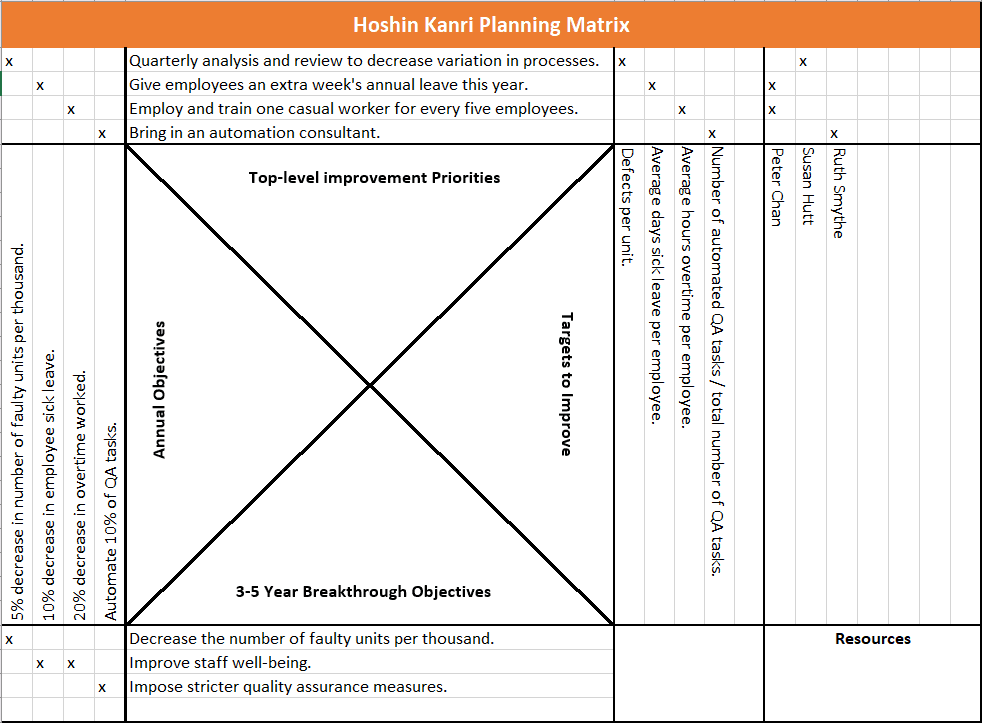
Communication and Catchball
Because communication is such an integral part of Hoshin Kanri, it’s important to get it right.
Catchball is a strategy that helps to foster two-way communication in an organization.
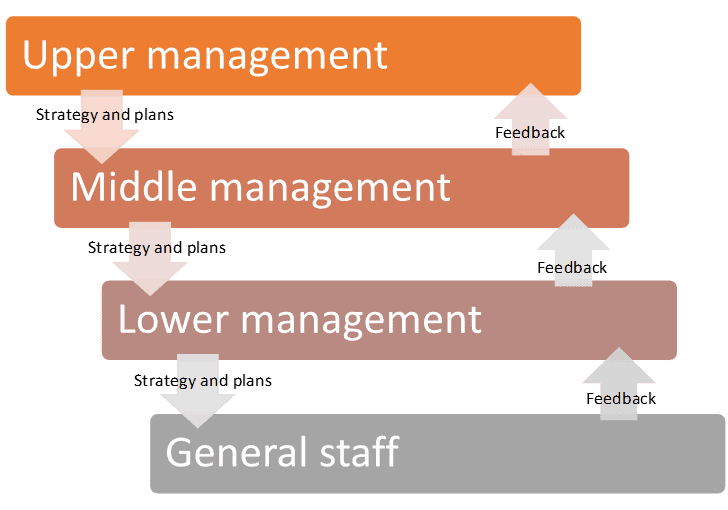
Think of it like a game of catch with specific rules:
- Upper management throws the ball to middle management, explaining high-level strategy and plans.
- Middle management throws the ball to upper management, giving feedback and ideas about the plans communicated.
- Upper management throws the ball to middle management with amendments created using the feedback provided.
- Middle management throws the ball to lower management, explaining the strategy and department-level plans.
- Lower management throws the ball to middle management, giving feedback and ideas about the plans communicated.
- Middle management throws the ball to lower management with amendments created using the feedback provided.
- Lower management throw the ball to their staff, explaining the strategy and team-level plans.
- Staff throw the ball to lower management, giving feedback and ideas about the plans communicated.
- Lower management throws the ball to staff with amendments created using the feedback provided.
When you’re ready, there are a few ways I can help:
First, join 30,000+ other Six Sigma professionals by subscribing to my email newsletter. A short read every Monday to start your work week off correctly. Always free.
—
If you’re looking to pass your Six Sigma Green Belt or Black Belt exams, I’d recommend starting with my affordable study guide:
1)→ 🟢Pass Your Six Sigma Green Belt
2)→ ⚫Pass Your Six Sigma Black Belt
You’ve spent so much effort learning Lean Six Sigma. Why leave passing your certification exam up to chance? This comprehensive study guide offers 1,000+ exam-like questions for Green Belts (2,000+ for Black Belts) with full answer walkthroughs, access to instructors, detailed study material, and more.


Comments (2)
Hi Ted,
The BMGI video was confusing for me as I though this was an explanation for the matrix, not how it can be repeated and cascaded through an organisation.
Maybe better in a section after explaining the individual phases ?
That’s a fair criticism, Jonathan.
I added a short, specific walkthrough for the x matrix and moved how to propagate the concept through the organization after that.
How does that flow?
Best, Ted